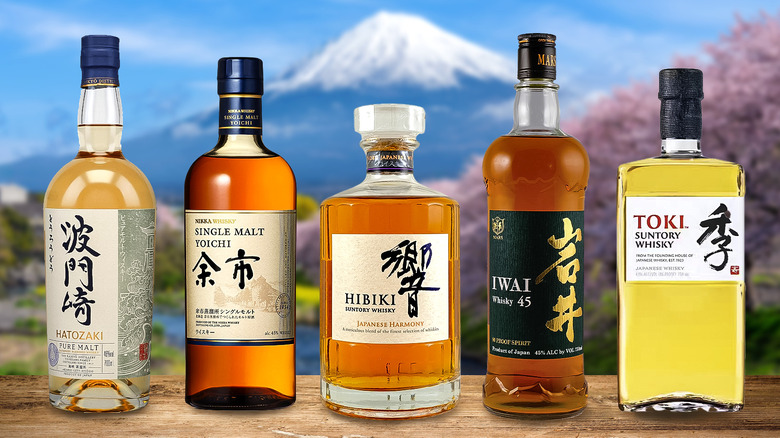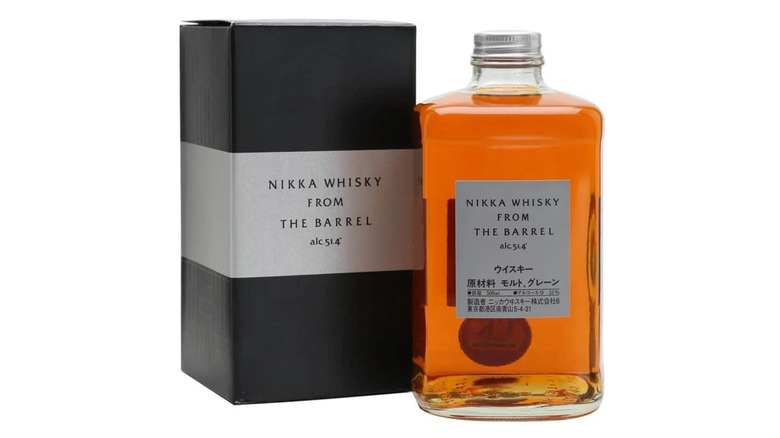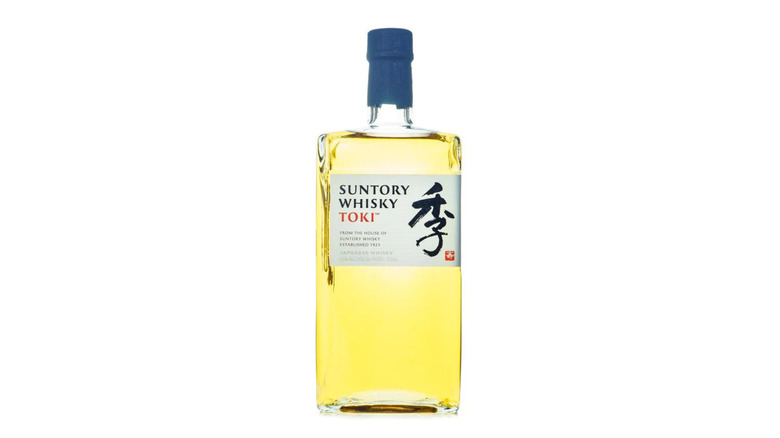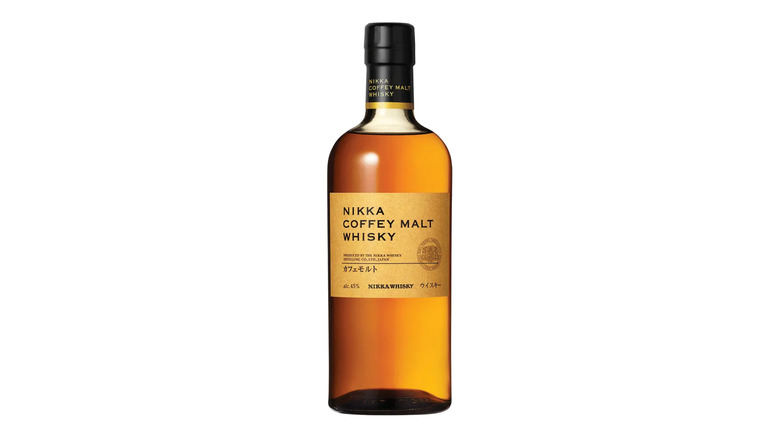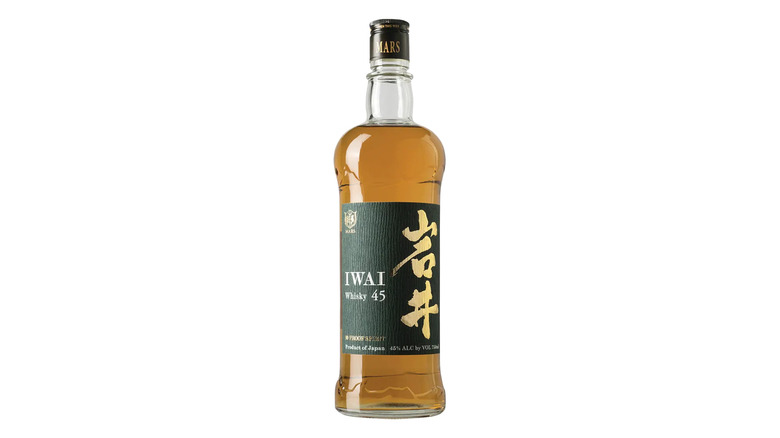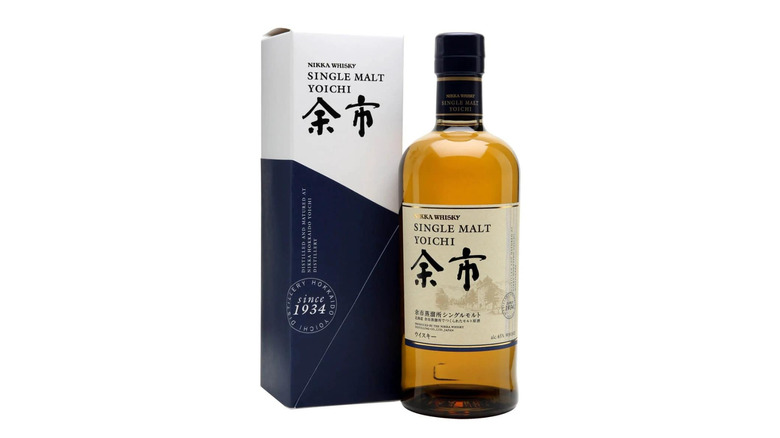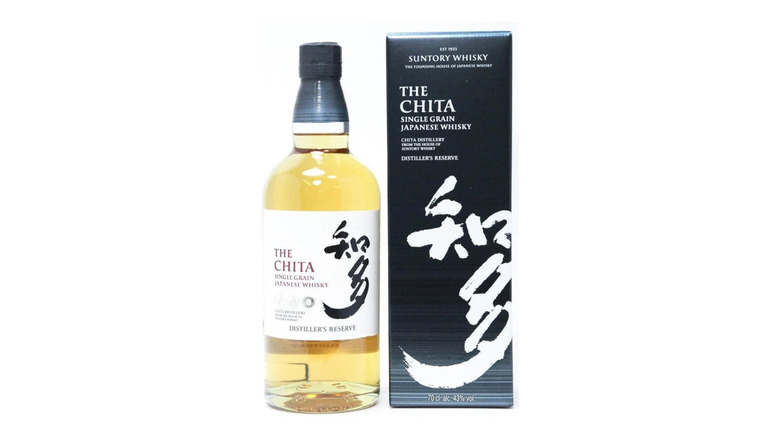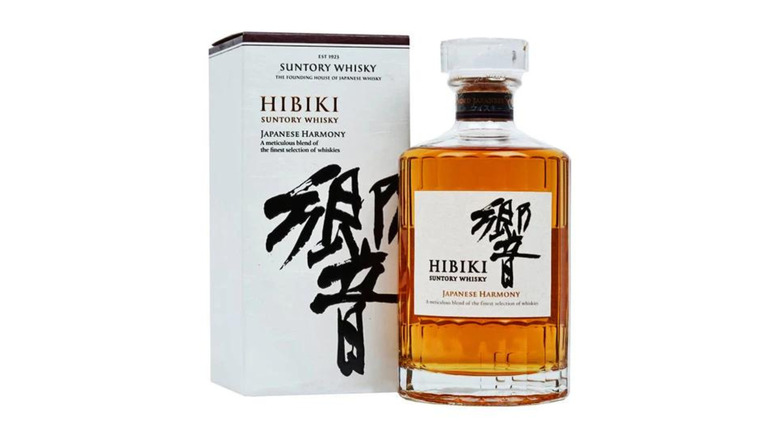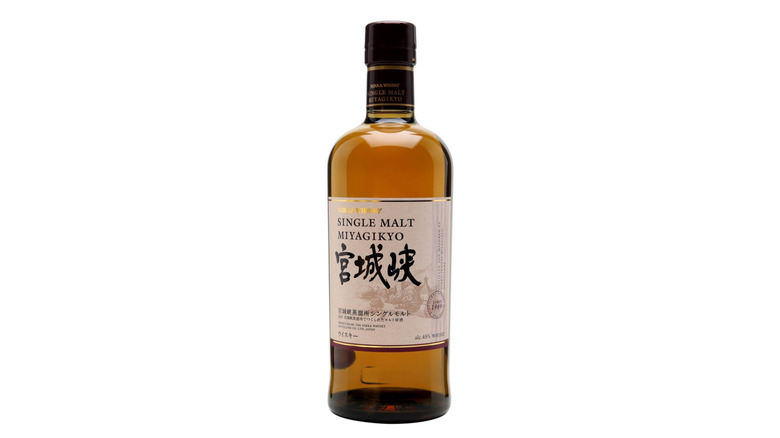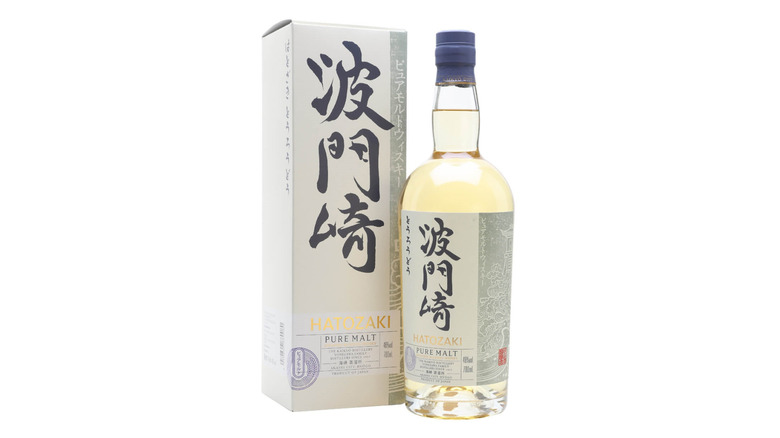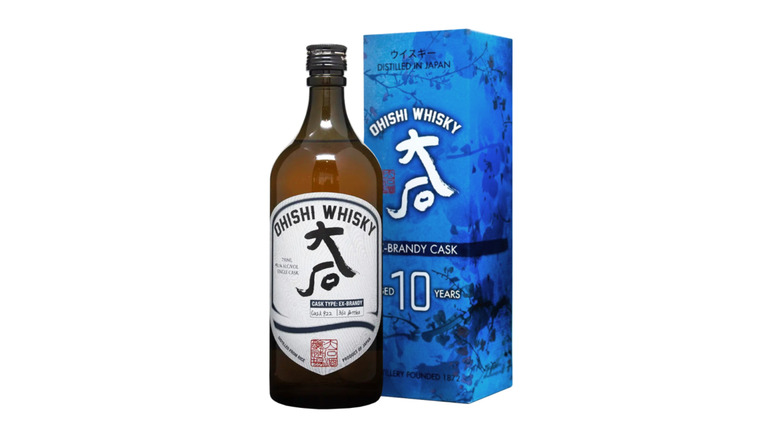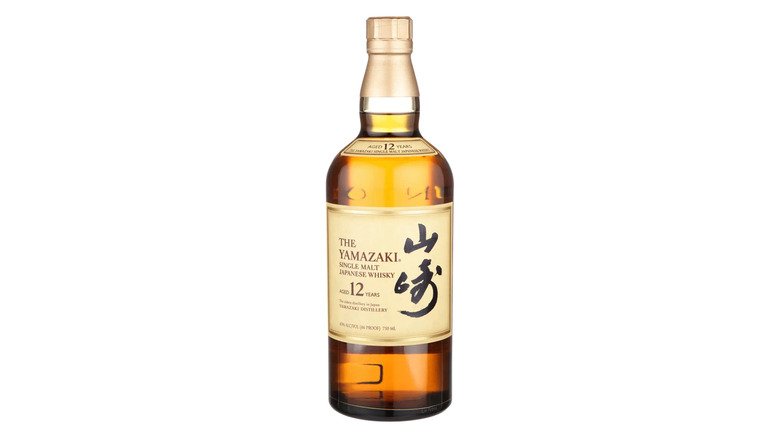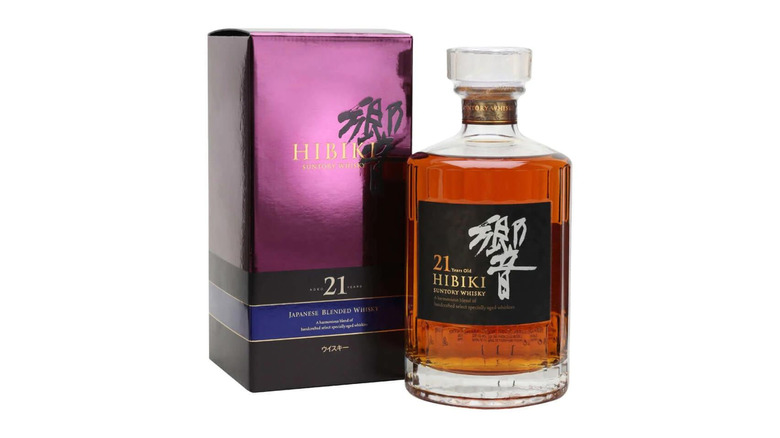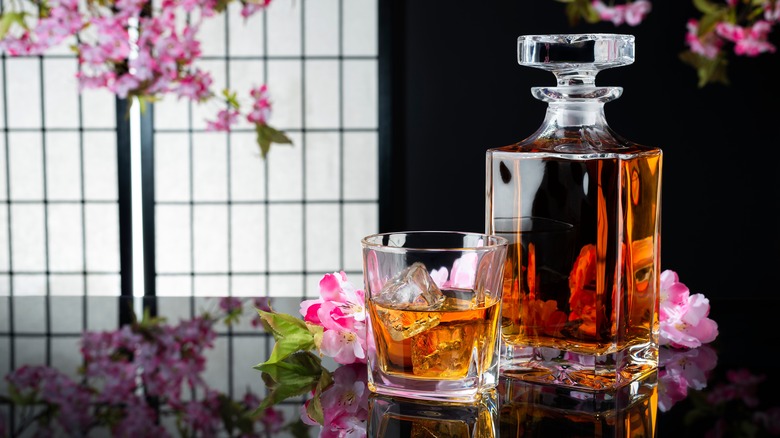The 12 Best Japanese Whiskies
The world of Japanese whisky is one that has delighted connoisseurs, despite dealing out a measure of frustration. For the most part, today's Japanese whiskies can trace their roots back to Scotland, after the modern industry's founding fathers were inspired to recreate scotch at home with its own distinctly Japanese flavor. The result was a collection of exemplary whiskies, which were largely overlooked by the global market until a few decades ago. The international introduction of Japanese whiskies took the world by storm, and as they began to garner globally recognized accolades, business continued to boom.
The drawback, however, was that this surge in popularity came as something of a surprise to Japan's distillers, who weren't prepared to meet the demand. As older whiskies were used up, even the country's most prominent whisky-makers were forced to replace them with younger, non-age statement (NAS) blends, meaning some of the best bottles are rare and can be eye-wateringly expensive.
In the interest of accessibility, this list contains whiskies that are still relatively easy to get hold of, and includes a handful of whiskies that might not be considered world-class, but are excellent value for money and will easily tide you over while Japanese distillers replenish their supplies. They are also all bottles that I've personally tried over a long career in hospitality, and have been of a high enough quality that I've stocked more than a few of them in bars and restaurants I've managed throughout my time in the industry.
Nikka From The Barrel
While Nikka whisky isn't the oldest name in Japanese whisky, it can certainly be credited with having a remarkable influence on the spirit's journey. After all, it was Nikka's founder, Masataka Taketsuru, who traveled to Scotland in the early 20th century to learn all he could about scotch whisky production. After bringing his knowledge back home and briefly employing his talents at the company that would eventually become Suntory, Taketsuru decided it was time to go it alone. His impact on Japanese whisky is undeniable, and the quality of Nikka's whiskies means it's a name we're going to see a few times in this list.
We're going to start with Nikka Whisky From The Barrel, an excellent whisky consisting of blends previously aged in sherry and bourbon casks that are then "married" for a few more months. The result is a bold and complex whisky, empowered by a higher-than-usual ABV of 51.4%. The aroma is fantastic, almost like an earthy berry cheesecake with a touch of smoke. The taste is much the same, with a fruity sweetness featuring notes of vanilla and subtle spice, and a malty, bready presence.
Suntory Toki
If there's a name that can be considered most synonymous with Japanese whisky, it's Suntory, which formed back in 1899 and started producing whisky in 1923. Suntory became so successful that it eventually bought the American whiskey powerhouse Beam Inc. The company's scale means that not only does it produce a wide range of spirits from its multiple brands and distilleries — some of which we'll see later — but it also makes whisky that can be considered affordable by most.
Suntory Toki is a blended whisky that showcases single malts from the company's Yamazaki and Hakushu distilleries, and includes single-grain whisky from its Chita facility. The result is a versatile spirit and a masterful combination of flavors. The nose is slightly floral with hints of citrus, featuring hints of vanilla, honey, and spicy oak. The taste is light and refreshing — characteristics alluded to by the liquid's pale straw coloring — and boasts grassy and floral elements along with more vanilla, honey, and bright, sweet lemon. However, despite Toki's delicate style, which isn't as deep and rich as other whiskies, an ABV of 43% bolsters the mouthfeel in a way that lets you appreciate the flavors without the impression they've been watered down.
Nikka Coffey Malt
First, let's clarify that you're not seeing a typo here — the word Coffey refers to a type of column still rather than the caffeinated bean, so don't let it put you off this interesting dram. Typically, column stills are used in making grain-based whiskeys, like bourbon, so using them to make a malt whisky is an inventive concept if well executed. The Coffey Malt also has a sibling, Coffey Grain, with a mash bill of 95% corn and 5% barley, and while it's certainly tasty and can be a great way for bourbon lovers to step into the world of Japanese whisky, the Malt version is arguably better and more intriguing.
Made with 100% malted barley, Coffey Malt offers a unique aroma that combines butterscotch with tropical fruits and toasted notes, almost like warm banana bread. At 45% ABV, the nose is a little hot, but the extra strength makes the mouthfeel richer overall. The palate features more fruit, honey, and butterscotch, alongside dark cocoa and a touch of rye-like spice, presenting a pleasant sweetness that isn't quite as syrupy as corn-based whiskies. The finish is on the lighter side, which is surprising given the previous depth of flavor, but just means you'll be ready sooner for the next inviting sip.
Mars Shinshu Iwai 45
When Hombo Shuzo Ltd relocated its production to the Japanese Alps in 1985, the Mars Shinshu distillery was born. Here, they were able to take advantage of the region's cool climate to slow the maturation of their whisky, as well as the extremely soft water from snowmelt-fed aquifers.
Iwai 45 is the higher-proof version of Mars Shinshi's original Iwai whisky, and we've chosen it here with good reason. While most Japanese whiskies are scotch-inspired, Iwai takes its lead from America, utilizing a mash bill of 75% corn and 25% malted barley, and aging in ex-bourbon casks. What we end up with is a whisky that works well as a sipper, especially compared to the original Iwai, but that shines brightest in cocktails. In particular, the whisky highball is a Japanese favorite.
The nose of this whisky offers a combination of caramel, red berries, and tropical fruits, with a smattering of maltiness that doesn't overpower the delicate aromas. When we get to tasting, the malt starts to take control, expressing zippy orchard fruits and citrus, with a noticeable lack of woody characteristics. The finish is on the short side, becoming slightly bitter towards the end. It's not unpleasant but highlights why Iwai 45 is best used for mixed drinks.
Nikka Yoichi Single Malt
Nikka's Yoichi Single Malt is named after and produced in the company's original distillery, founded in 1934. Located in Hokkaido, Masataka Taketsuru chose the town of Yoichi specifically because of how similar the climate and terroir were to Scotland's, where he had spent years honing his craft.
This particular whisky was introduced by Nikka in 2016 as a replacement for their discontinued age statement Yoichi range. While the good news is the distillery has recently relaunched a 10-year expression, the NAS version is much more affordable and easier to find, and it's arguably better value for the time being.
Thanks to Yoichi's use of coal-fired stills, this particular single malt has a smoky, earthy character that's reminiscent of an Islay scotch. However, like many elements of Japanese whiskies, these notes are delicate, lacking the intensity of peat bombs like Laphroaig. Both tropical and orchard fruits shine through the smoke on the nose and palate, and there's a briny minerality that balances the profile well. The finish is short, as might be expected from a NAS whisky, but the smoke makes a welcome reappearance before the end.
The Chita Single Grain
This particular whisky comes from Suntory's grain distillery, Chita, and is one of the expressions blended into some of the company's other whiskies, like Toki. The term single grain means the whisky is distilled with a non-barley grain from a single distillery, much in the way that single malt refers to whisky made with one hundred percent malted barley from a single distillery.
The Chita's mash bill is predominantly corn-based, and it's made with a blend of whiskies aged in ex-bourbon, sherry, and wine barrels. The nose is subtle, but there's a detectable bourbon-like sweetness with a presence of orchard fruits and a hint of anise.
The body is light in both color and mouthfeel, as might be expected of a whisky in this style. On the palate, there are more similarities with bourbon, with notes of vanilla, caramel, oak, and cinnamon spice. The finish is short with a floral element and a light, baked cereal taste. While The Chita might not be considered a top-shelf Japanese whisky, it's affordability and clean, mellow profile make it an appealing entry-level option for those who prefer an easy-drinking tipple.
Hibiki Japanese Harmony
Like Toki, Hibiki "Japanese Harmony" is a whisky made from a blend of malt and grain whiskies from Suntory's three distilleries — Hakushu, Yamazaki, and Chita. There are a few special editions and variants of Harmony, but today we're sticking to the standard 43% ABV expression.
Harmony lives up to its name by masterfully combining whiskies aged in five different barrel types, including ex-sherry and bourbon casks, and highly sought-after Japanese mizunara oak casks. While Harmony might not have the consistent depth of other Japanese whiskies, it's an interesting drinking experience, as the bold aroma leads to a surprisingly smooth and mellow-tasting dram with a somewhat abrupt finish.
The rich nose boasts notes of golden honey, crisp apple, citrus, and oaky spice, flavors that are present but less intense on the palate. It's a whisky that's on the sweeter side but not sickly, while the mouthfeel is still buttery despite the lighter texture. Harmony's main drawback is its current price, as a few years ago, it could be considered great value for money. However, as the cost of Japanese whiskies has continued to rise, it's starting to reach a point where that might no longer be the case.
Nikka Single Malt Miyagikyo
When Masataka Taketsuru was looking for a site for Nikka's second distillery, he deliberately chose a location that differed from Yoichi. In 1969, the Miyagikyo distillery started producing whisky in a valley located in the Miyagi region.
For the sake of creativity, Taketsuru also decided Miyagikyo should use different production methods to the Yoichi distillery. For example, while Yoichi's stills are coal-fired, the newer distillery uses indirect steam to heat theirs, resulting in an elegant, fruit-forward whisky. Like the Yoichi Single Malt, the Miyagikyo age statement range was replaced by this single NAS expression in 2016; however, there's no news yet on whether this range will also be revived.
The Miyagikyo has a vibrant nose, with notes of honey, vanilla, and citrus imparted by ex-bourbon barrels. There's not an abundance of oak, but in its place are peated and non-peated malt elements, like sea salt and biscuits. While the whisky's lack of maturity means it lacks the depth of its predecessors, the mouthfeel is creamy, and its bright, fruity flavor profile is complemented deliciously with honey and stone fruit, and the spicy oak notes become more prominent. The finish isn't remarkable, but it's impressively rounded for a NAS whisky.
Hatozaki Pure Malt
While the Akashi Sake Brewery has been distilling spirits for over a hundred years, it wasn't until 2017 that the company's head distiller, Kimio Yonezawa, launched the Kaikyō Distillery dedicated to making gins and whiskies. The youth of the distillery means it's still operating on a relatively small production scale and can't yet produce a single malt expression, as it relies on whisky from other distilleries to bulk up its blend.
However, as we've seen with scotch, being a single malt doesn't mean a whisky isn't worth trying, in the same way that it doesn't guarantee excellence, and Hatozaki's blend has improved over time. Aged in a combination of bourbon, sherry, and mizunara oak casks, Hatozaki's whole-malt mash bill is an inviting experience. The aroma is straightforward and features many elements common in younger whiskies, like unripe orchard fruits, grass, crackers, and a touch of malt funk.
The sweet malt flavors are present again on the palate, with rich honey, and touches of vanilla and peppery oak from the aging. There's also a light minerality that balances nicely with the whisky's creamy and nutty notes. The honey remains present through to the finish, at which point some modest smoke pokes through and lingers pleasantly.
Ohishi Whisky 10 Year Brandy Cask
Although scotch-inspired whisky became more prominent in the early 19th century, it's not like the Japanese were strangers to the spirit. Traditionally, Japanese whisky was made with rice as its primary grain, and the Ohishi distillery was founded back in 1872 in a region with a distilling history that stretches all the way back to the mid-16th century.
Ohishi's whiskies are made with one hundred percent rice in the mash bill, before being aged in ex-sherry or brandy casks which impart a variety of delicious and unique flavors. Ohishi isn't afraid of experimentation, with expressions that are finished in a range of different casks, including ex-Islay scotch and port casks, and cherry blossom barrels.
However, the whisky that stands out is one that's been continually aged in brandy casks for 10 years. The rice gives the nose a delightfully floral, sake-like quality that's intensified with oak and fruit from the aging process. The palate is equally complex, as sweet tropical and orchard fruits vie for attention while oak spice dances across the tongue. The rice also lends the whisky a silky smooth mouthfeel, and the finish is beautifully long, with the existing flavors enhanced by a touch of sea salt before gently fading away.
The Yamazaki 12 Years Old Single Malt
Hailing from Suntory's famous Yamazaki distillery, Japan's first to produce malt whisky, the Yamazaki 12 Years Old Single Malt is the company's flagship expression. Despite being released in 1984, it wasn't until Yamazaki 12 won the Double Gold Medal Award at the San Francisco World Spirits in 2013 that the international crowd sat up and took notice. Fortunately, Yamazaki 12 is still relatively easy to get hold of, despite an inflated price tag that will set you back a couple of hundred dollars. However, many would argue it's still worth the money, and that it perfectly demonstrates what Japanese whisky is all about.
The nose of Yamazaki 12 hits like a bullet train. Fruits like cherry, apricot, pineapple, and prunes burst from the glass along with hearty notes of honey and vanilla, but there's a notable lack of the alcoholic heat that often accompanies such bold aromas. The palate is complex yet delicate, as the tropical elements become more prominent along with the honey and vanilla. There are hints of chocolate present, and the oak becomes more noticeable before a long finish that sees the profile take a turn to dried fruits, bolstered by touches of cinnamon and roasted malts.
Hibiki 21 Year
We mentioned earlier how a whisky being a single malt doesn't necessarily correlate to quality, and the blended Hibiki 21 Year, made with a blend of malts from Suntory's Yamazaki and Hakushu distilleries, is arguably the best proof of this. It's a whisky that's earned every one of its numerous awards year after year, and while it may take some effort to locate a bottle and will likely set you back four figures, it would be a crime not to feature it on this list.
Blended from whiskies matured for at least twenty-one years in a combination of bourbon, sherry, and mizunara casks, the Hibiki 21 has a remarkable depth that truly shows its age. The nose is powerful and sweet, with notes of dark toffee and dark fruits, candied citrus, old oak, and wafts of smoke. These aromas come together harmoniously on the palate, tasting something akin to rich fruitcake with a full, oily body that manages to retain the elegance associated with Japanese whiskies. With each sip, more nuanced flavors start to appear, like nuts, sweet grapes, and golden syrup. The finish is wonderfully long, as each layer of the profile slowly fades away, with delicate smoke being the last to go.
Methodology
When I began to create this list of whiskies, I felt it was important to factor in the current state of the Japanese whisky market, as outlined at the start of this article. Ultimately, this meant leaving out some whiskies that would definitely have made the cut if accessibility and price were no object, because I felt it didn't make sense to sing the praises of bottles most people will never get the chance to taste.
Over a long career in hospitality and a personal passion for exploring world whiskies throughout my travels, I've been fortunate enough to try every whisky listed above and can attest to their quality. When I've been in a position to create whisky lists for establishments I've run, these are the ones I would turn to, and many have found a place behind the bars I've managed and worked at.
